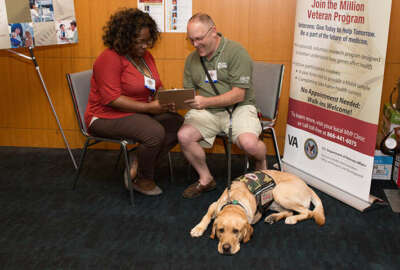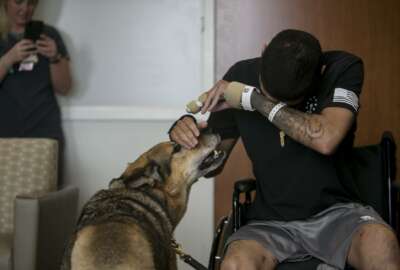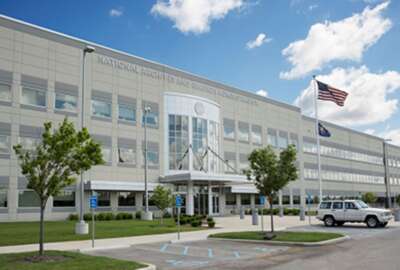VA’s million veterans program, now has a million veterans
Over a decade ago, the Department of Veterans Affairs launched an ambitious project to build the world’s largest collection of health and genetic data – the...
Over a decade ago, the Department of Veterans Affairs launched an ambitious project to build the world’s largest collection of health and genetic data – the idea being it would be an invaluable tool for disease research. It is called the Million Veterans Program (MVP). And as of this month, it has lived up to its name. There are now a million veterans enrolled and in the dataset. For some of what VA has been doing with the dataset, Federal News Network Deputy Editor Jared Serbu talked to MVP Program Director Dr. Sumitra Muralidhar on the Federal Drive with Tom Temin.
Interview Transcript:
Jared Serbu Dr. Muralidhar, thanks for being with us. Talk to us a bit about the origin of the Million Veteran program. Is this about the cadence that you were expecting in terms of how long it would take to finally reach a million?
Sumitra Muralidhar Well, that’s a great question. So first of all, traditionally, how genetic studies were done were in silos. Like there would be an investigator who was interested in looking at the genetics of diabetes or heart disease, and they would enroll maybe a couple of thousand patients and controls and do their analysis. So it was kind of a siloed approach and in small numbers. So our vision was really kind of bold and game changing. We wanted to really enroll at least 1 million veterans into this program, collect the genetic information and their lifestyle and military experiences and exposure information. And when we have one of the best electronic health records in the VA so we could get access to the health records and establish this mega database where researchers can now not just query one disease condition, they could look at any disease that has represented with a million people we’re going to be seeing all sorts of health conditions represented that we see among veterans.
Sumitra Muralidhar So that was the first thing. The second was the scale. Instead of looking at a few thousand. Now they can look at tens of thousands of people with a particular condition or even hundreds of thousands of people in this specific condition. And the third thing was diversity. Traditionally most genetic studies done on people of European descent. And here we wanted to leverage the diversity in the veteran population. Now we recently enrolled our millions. And really, as you know, we’re past the million. And we have over 180,000 veterans of African descent represented to the program. And over 80,000 veterans that are Hispanic, over 100,000 women represented. So now we’re able to ask or make discoveries not only across different ancestries, but even discoveries of genetic markers specific to our population. So that was the goal when we first started out to say, let’s change the paradigm here from individual researchers asking questions in small numbers of a particular condition and really create this large resource that can be tapped into. And our ultimate goal really was to be able to use this information to advance personalized or precision health care, meaning personalized treatments or personalized screenings based on the genetics or lifestyle and the medical history of an individual better. That’s our ultimate goal.
Jared Serbu Yeah. So it sounds like the objective has always been to enable generally applicable medical research and not solely research that applies to veterans, although I’m sure you get that, too.
Sumitra Muralidhar Yes, absolutely. I mean, so a lot of the conditions we see in our veterans are also seen in the general population, chronic conditions like heart disease, mental health issues, kidney disease, cancers. So anything we learn from this program in veterans is going to be applicable to the population at large.
Jared Serbu And although you only recently reached the 1 million mark, the data set has been around and in progress for quite a while now. So what have researchers been able to glean from this large dataset so far? Can you tell us about some of the research that’s been conducted and any treatments that have come from that?
Sumitra Muralidhar Oh, absolutely. So we didn’t wait till we reached 2 million to start doing the science. So we started curating the data and making it available. So we have over 100 projects and over 350 scientific publications that have come out from this dataset in all conditions in mental health, PTSD, depression, anxiety, TBI, heart disease, various cancers. So the entire spectrum of any condition you can think of and some that are specific like tinnitus, that we see among veterans, you know, that’s a TBI that’s more common in veterans. We’ve been able to do studies in these. And as I mentioned earlier, some of the largest studies we have done a genetic association study in 165,000 veterans of PTSD. Anxiety, one of the largest ever done, and 200,000 veterans, depression and 300,000 veterans. So this has never been done before. And what we’ve found is not only confirmed previous findings. We have identified new genetic markers across ancestries and also provide identified genetic markers that are specific to. To African-Americans and Hispanics in terms of depression, even PTSD. So there are certain conditions where we have identified specific genetic markers.
Sumitra Muralidhar Now, in terms of your question about treatments, we are just now moving into that phase of trying to see what discoveries are appropriate, but now moving into the clinic. And what does that pathway look like? And I can give you a couple of examples. Prostate cancer common in men, especially specifically of African-American descent. And the lethal form of cancer prostate cancer is not seen in everybody. Everyone doesn’t progress to the lethal form of metastatic prostate cancer. But there’s no way of telling who will progress to that. So generally, the treatment is prostatectomy because we don’t currently have a way of predicting that. So one of our studies on metastatic prostate cancer identified a number of genes together that can predict risk for the more dangerous form the metastatic prostate cancer, and that’s called a poly genic risk score. So they’ve developed a polygenic risk score. And now in the VA funded clinical trial, we are testing it to say if we did standard of screening for prostate cancer, comparing that with standard of care screening, plus adding this polygenic risk score. Will we be able to identify who progresses to the more dangerous form earlier so we can really focus and target the aggressive treatments for those people who are at a higher risk? That’s one example. And I’ll give you another one. And that’s in end stage renal disease. Again, people of African descent as well as Hispanics are more prone to end stage renal disease. And our researchers studying this found a specific genetic marker in this case that is beneficial. So not all genetic markers are bad and increase the risk. But in this case, they found a protective genetic marker. And then going into the mechanism of how that marker is protecting people from progressing to end stage renal disease, they found that there could be it sort of you could have medications, drugs that can mimic this effect. So now it’s not within the VA, but there is a pharma that has now testing a drug that mimics the effect of this protective genetic marker to see if that can benefit people with chronic kidney disease and prevent them from progressing to the end stage renal disease. Yeah, these are a couple of examples of.
Jared Serbu Yeah. And that pharma point you just made actually gets to the next question I was going to ask, which is, when you talked about all the research that’s been ongoing, you use the word we a lot. Is this data set also available to researchers who were not directly or formally affiliated with VA? And if so, how do you control the data? How do you protect privacy, that sort of thing?
Sumitra Muralidhar So right now, the data are available to VA researchers, but nearly all of our studies have academic researchers on the project because most of our VA researchers also have appointments at an affiliated university. So our research teams include collaborators. They may not directly touch the data because you have to have a VA appointment and a VA account to be able to access the data within the VA system. But we are looking, we are actually beta testing a VA data commons outside the VA firewall right now, and that is where we in the future hope to provide access to de-identified MVP data to the broader research community. In addition, we recently conducted one of the largest genome wide study. And that means like, generally people take a single genetic marker and see what health conditions it’s associated with, or they take a single disease like diabetes and say, How many genetic markers that are associated with diabetes. We looked at almost 45 million genetic markers and took a little over 2000 health conditions. And this is using the supercomputers at the Department of Energy where we would able to do those associations. And the summary results will be available to the broad research community. And they can then build future hypotheses based on those. So it’s another way the summary data from all our analysis are available to the broader community.
Sumitra Muralidhar Now, you asked the question about how do we secure and protect privacy and confidentiality. So that is one of our highest priorities. And so end to end, from the point of collection to the point of use of the data, we have a number of mechanisms in place to protect the data. First of all, it’s it’s coded. We don’t use direct identifiers such as name or date of birth or Social Security numbers on the black tube. Let’s say we collect the blood specimen. It’s coded, has a barcode. Similarly on the surveys that veterans complete. So we do have an honest broker system that can link it back to the veteran. And we have very few people who access to that and authorized individuals. But throughout the journey, the lifecycle of this data from collection to use, it’s coded. That’s one thing. And then the second thing is we bring researchers to the data in a centralized, secure scientific computing environment, meaning we’re not distributing data sets out. We have a central environment. We provide all the analytic tools that researchers need. And researchers were approved for access, access the data in this system, do the research, the analysis, and they can only take up the results that they need for their publications and other things. So that’s another mechanism by which we protect the privacy and confidentiality. So the data never leaves our central system.
Jared Serbu And last thing I wanted to ask you is, now that you’ve reached a million, I’m assuming you’re not going to stop and that you’re going to want to continue to impanel veterans into this program so that you continue to get a contemporary read on things. How do you think about that whole process going forward and how do veterans who are interested enroll?
Sumitra Muralidhar Yeah, so definitely we’re not going to stop. We’re going to continue. What we will do is focus on increasing the underrepresented populations. So I mentioned over 180,000 African Americans and 80,000 Hispanics, women 100,000. But we can do much better than that. And the goal is to now go focus our recruitment efforts on those populations and others like Native Americans, Pacific Islanders, Asian-Americans, those are much more underrepresented. We want to increase all those, and even medical conditions. What are the conditions? Where are the gaps in this large dataset? What are we not seeing and focus and enrolled veterans on that? And so it’s open, and there are two ways. We have about 70 sites around the country right now that where veterans can enroll in person. And they can also enroll online with an online portal. And the address for that is mvp.va.gov. So if they go to the portal, they can enroll online, complete the consent process, complete surveys online. They can schedule their own appointments at the VA to give a blood specimen, or they can opt for getting a kit mailed home where they can do a blood draw, a small amount of blood to get that they can do that and send it back to the VA. And if they go to the website, there’s also a number there for our information center. If they have additional questions, they can ask about the program and even have appointments made by our call center staff as well. I just wanted to call out the altruism and the spirit of service of our veterans, and that is why we’re here today. Without that, we would not have been able to get to where we are or take this forward even. And this is really a legacy that they’re leaving behind. And it’s a gift to the world because this database, we expect is going to be there forever and generate new information and bring it back to improve health care for all people.
Copyright © 2025 Federal News Network. All rights reserved. This website is not intended for users located within the European Economic Area.
Jared Serbu is deputy editor of Federal News Network and reports on the Defense Department’s contracting, legislative, workforce and IT issues.
Follow @jserbuWFED






